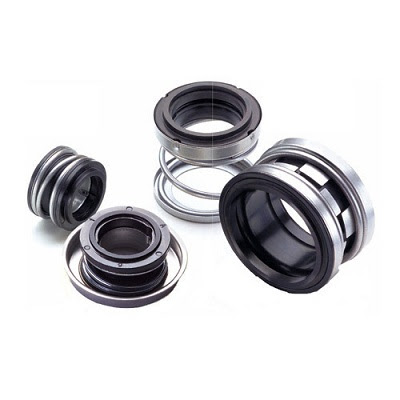Information on pump shaft seals is useful.
What exactly is a pump shaft seal?
Shaft
seals keep fluids out of a rotating or reciprocating shaft. This is crucial for
all pumps, and in the case of centrifugal pumps, numerous sealing choices will
be available, including packings, lip seals, and all sorts of mechanical seals,
including cartridge sealant. Rotary positive displacement pumps, such as gear
pumps and vane pumps, include packing, lip, and mechanical seal configurations.
Reciprocating pumps have unique sealing challenges and often rely on lip seals
or packing. Magnetic drive pumps, diaphragm pumps, and peristaltic pumps, for
example, do not require shaft sealant. These seamless pumps have fixed sealant
to prevent liquid leakage.
What are the different kinds of pump shaft seals?
Packing:
Packing
(also known as shaft packing or gland packing) is often made of a soft material
that is braided or molded into rings. To form a seal, this is forced into a
compartment around the driving shaft known as the stuffing box. Compression is
often applied axially to the packing; however, a hydraulic media can also apply
compression radially.
Packing
used to be composed of leather, rope, or flax, but it is now commonly made of
inert materials such expanded PTFE, compressed graphite, and granulated
elastomers. Packing is a low-cost method of transporting thick,
difficult-to-seal liquids such as resins, tar, or adhesives. However, it is a
poor means of sealing thin liquids, especially at high pressures. Packing
seldom fails catastrophically, and it may be rapidly changed during scheduled
shutdowns.
To
minimize frictional heat buildup, packing sealant must be lubricated. This is
normally supplied by the pumped liquid, which leaks somewhat through the
packing material. This is typically unacceptably untidy in the event of
caustic, flammable, or poisonous liquids. In such instances, a safe external
lubricant may be used. Packing is inappropriate for sealing pumps used with
abrasive particles in liquids. Solids can become embedded in the packing
material, causing damage to the pump shaft or the stuffing box wall.
Lip seals
It
is also known as radial shaft seals, are basically round elastomeric corridors
held against the driving shaft by a stiff external covering. The seal is formed
by the frictional contact between the' lip' and the shaft, which is constantly
supplemented by a spring. They are frequently set up on pumps, hydraulic
motors, and selectors in the hydraulic sector. They constantly serve as a
backup seal for other sealing systems, similar to mechanical seals.They are
often confined to low pressures and perform poorly with thin, non-lubricating
liquids. Several lip seal technologies have been successfully tested against a
wide range of viscous, non-abrasive liquids. It should not be used with
abrasive liquids or fluids containing solids since they are prone to wear and
any minor damage can lead to failure.
Mechanical Seal
They are made up of one or further dyads of
optically flat, largely polished faces, one of which is fixed in the casing and
the other rotating and attached to the driving shaft. The faces need to be
waxed, either by the pumped liquid or by a hedge fluid. In practice, the seal
faces come into touch only while the pump is at rest. During operation, the
lubricant creates a thin, hydrodynamic subcaste between the opposing seal
faces, dwindling wear and tear and aiding with heat dispersion.
They are capable of withstanding a broad range
of liquids, viscosities, pressures, and temperatures. A mechanical seal, on the
other hand, should not be run dry. The fact that the drive shaft and casing are
not part of the sealing mechanism (as is the case with packing and lip seals)
means that they are not prone to wear.
Double Seal
They are made up of two mechanical seals that
are placed back to back. The gap between the two sets of secure faces can be
hydraulically pressurized with a barrier liquid, such that the film required
for lubrication is the barrier liquid rather than the medium being pumped. The
barrier liquid must also be compatible with the medium being pumped. Because of
the necessity for pressurization, double seals are more difficult to operate
and are normally employed only when it is required to protect humans, external
components, and the surrounding environment from dangerous, poisonous, or
flammable substances.
Tandem seals
They are identical to double sealant, except that the two sets of mechanical
seals face each other rather than back-to-back. In the pumped fluid, only the
product-side seal spins, but seepage across the secure faces ultimately
contaminates the barrier lubricant. This has implications for the atmosphere's
side seal and the surrounding environment.
Seals for cartridges
It is a mechanical sealant component package that has been
pre-assembled. Cartridge architecture reduces installation concerns such as
measuring and adjusting spring compression. During installation, the seal faces
are also shielded from harm. They can be formed into a sleeve in a single,
double, or tandem arrangement housed within a gland.
Seals for gas
barriers
These are cartridge-style dual seats with faces
that are pressurized utilizing an inert gas as a barrier, rather than the
typical lubricating liquid. By altering the gas pressure, seal faces can be
detached or retained in loose contact during operation. A trace quantity of gas
may escape into the product and the environment.
Summary
Shaft seals keep fluids from leaking from the
spinning or reciprocating shaft of a pump. Packings, lip seals, and other forms
of mechanicalsealant - single, double, and tandem, including cartridge seals -
are frequently offered as sealing choices.




Comments
Post a Comment